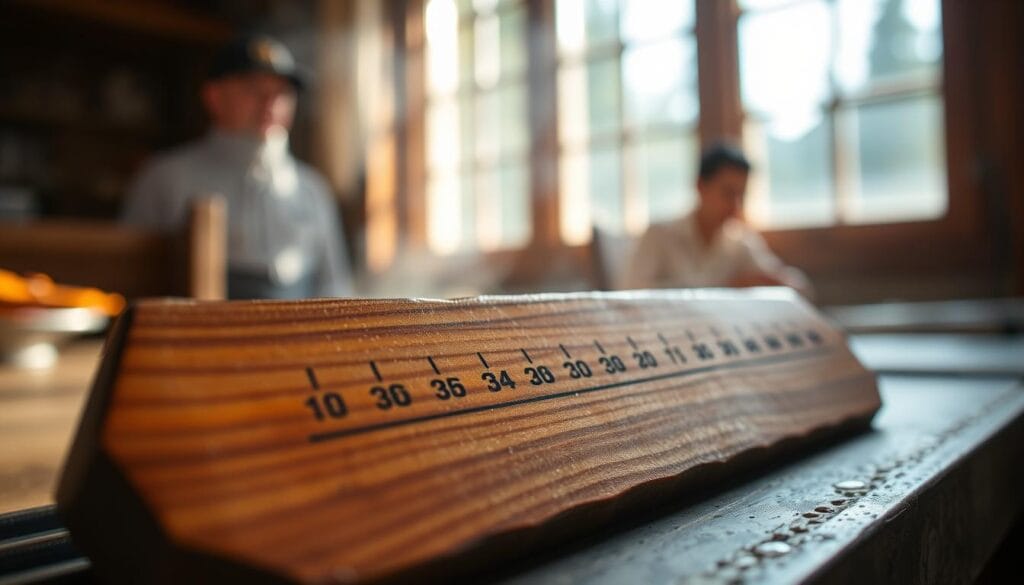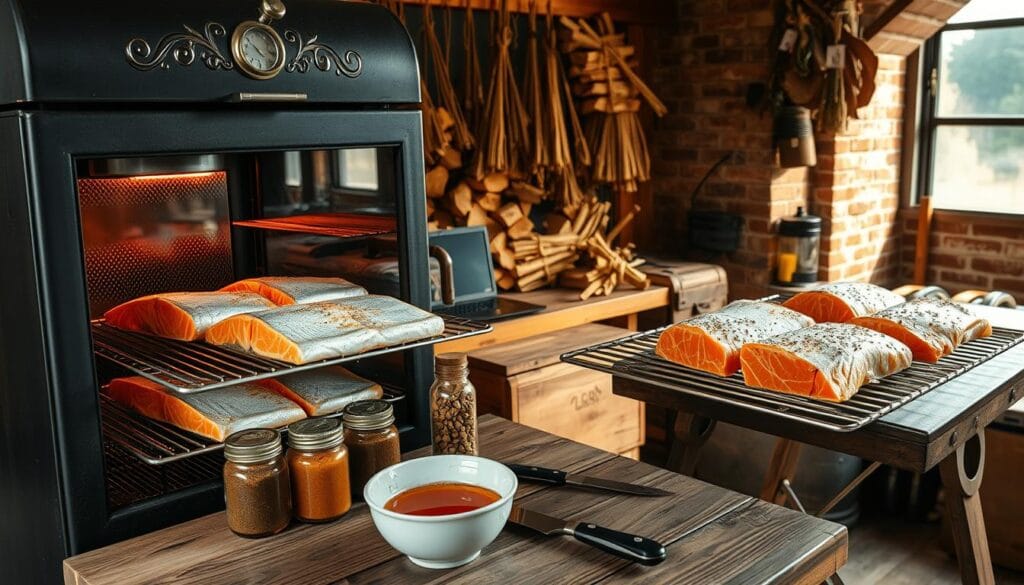Smoked Salmon Brine Recipe
Imagine slicing into silky-smooth smoked salmon that melts on your tongue. Its smoky sweetness balances perfectly with a hint of salt. This is the magic of a well-crafted smoked salmon brine.
Salmon is America’s favorite fish, and it’s a staple at holidays and brunches. But what makes it so special? It’s the brine. This step isn’t just about flavor; it’s science. The right mix of Diamond Crystal kosher salt and light brown sugar in your smoked fish brine keeps the meat tender.
Whether you’re hot-smoking at 225°F or cold-smoking for over 12 hours, the brine makes a difference.
Think about your last summer cookout. Did that store-bought lox ever match homemade? A proper brine cuts through guesswork. By brining salmon for 5 hours, you lock in moisture and avoid a rubbery texture.
This recipe’s 11.5-hour process—10 hours chilling in cure, 1.5 hours smoking—creates a dish for 12-16 people. It’s about more than technique—it’s about enjoying that first bite that says, “This is how it’s done.”
Table of Contents
Understanding the Importance of Brining Salmon
Salmom is one of the most popular fish in America.
Brining turns salmon into something special. Without it, smoked salmon can become dry and lose its texture. Our tests showed that unbrined salmon turned watery and mushy. Let’s explore why smoked salmon brine is so crucial.
| Method | Texture | Flavor |
|---|---|---|
| No brine | Mushy | Bland |
| Dry salt | Firm | Salty |
| Dry salt+sugar | Firm | Balanced |
| Wet brine (salt+sugar) | Optimal firmness | Rich |
| All-salt wet brine | Firm | Overly salty |
Salt pulls moisture out of the fish through osmosis. Sugar and salt dissolve into the flesh. Proteins break down slightly, keeping juices inside. This science works for all smoked fish brine methods. Wet brines use water to spread flavors evenly.
A smoked salmon brine creates a sticky layer. This layer helps the smoke stick, enhancing flavor. Brined salmon holds smoke better, balancing salt and fat. Farm-raised Atlantic salmon, being high in fat, benefits the most from this process.
Essential Ingredients for the Perfect Smoked Salmon Brine
Creating a great smoked fish brine begins with the right mix. Start with 1 gallon of clean water and 1 cup of Diamond Crystal kosher salt. Kosher salt’s big crystals dissolve well, making sure the flavor spreads evenly.
Add 1 cup of white sugar and 1 cup of brown sugar. Brown sugar brings a rich taste from molasses.
For a better smell, add sliced onion, citrus slices, and crushed garlic. Use 1 dash of hot sauce for a bit of heat. Dry brine blends mix ½ cup brown sugar with ½ cup Diamond Crystal salt. Both methods balance salt’s preservative power with sugar’s sweetness.
| Wet Brine | Dry Brine |
|---|---|
| 1 gal water | ½ cup brown sugar |
| 1 cup white sugar | ½ cup Diamond Crystal salt |
| 1 cup brown sugar | Seafood seasoning mix optional |
| Citrus, onion, garlic | Pepper or spices |
Adding 3 oz of crab and shrimp seasoning mix can enhance umami. Use whole spices for better flavor. For dry brines, skip table salt because it clumps. A 12% salt and sugar mix by fish weight is key for safe and tasty preservation.
This ratio works for both wild and farmed salmon. Brown sugar adds a caramel taste, while white sugar caramelizes faster. Store leftover brine in airtight containers for up to 2 weeks. Now you’re set to mix your brine in section 4.
The Basic Smoked Salmon Brine Recipe
Choosing between wet or dry brining shapes your smoked salmon’s flavor. Whether you’re mastering the smoked salmon brine or planning how long to smoke salmon, timing is key. Follow these steps for results that balance salt and texture perfectly.
Testing proved dry brining for exactly 5 hours hits the sweet spot. Under 5 hours leaves fish underseasoned; over 5 turns it overly salty.
Wet Brine vs. Dry Brine Methods
- Wet Brine: Soak salmon in a salt-sugar solution (½ cup Diamond Crystal kosher salt + ½ cup brown sugar dissolved in water) for 12–36 hours. Best for deep flavor infusion.
- Dry Brine: Coat flesh with salt and sugar mix, then refrigerate uncovered for 5 hours. Saves space and simplifies cleanup.
Step-by-Step Mixing Instructions
- For wet brine: Dissolve salt and sugar in cold water. Submerge salmon, weight it down, and chill.
- For dry brine: Spread sugar-salt mix evenly over salmon flesh. Refrigerate on a rack to allow airflow.
Recommended Brining Times
Adjust time by cut thickness. Smoked salmon brine rules:
– Dry brine all cuts for 5 hours. No exceptions.
– Wet brine thinner cuts (like tail pieces) for 12–24 hours. Thicker center cuts can handle 24–36 hours.
Timing here sets the stage for smoking. Follow these steps, and your fish will be ready to shine in the smoker—no guesswork needed.
How to Prepare Your Salmon Before Brining
Before you start your smoked salmon brine, getting ready is key. Here’s how to prepare for the best results:
Selecting the Freshest Salmon
- Choose salmon with firm flesh that springs back when pressed
- Go for fish with a clean, salty smell, not a strong fishy smell
- Pick farm-raised Atlantic salmon or wild king (Chinook) for the best texture
| Type | Fat Content | Best Use | Availability |
|---|---|---|---|
| Atlantic Farm-Raised | High | Hot smoking | Year-round |
| Wild King (Chinook) | Very High | Premium dishes | Seasonal |
| Wild Sockeye | Medium | Budget-friendly | Summer/Fall |
Proper Cleaning and Filleting
- Rinse the salmon under cold water and dry it well
- Remove pin bones from the fillets with tweezers
- Trim off any extra belly fat for better brine absorption
Skin-on vs. Skinless
Keep the skin on for:
- It helps the salmon stay together during smoking
- It keeps the salmon moist
- It adds a nice texture contrast with the flaky flesh
Also, skin-on salmon makes serving easier after brining.
By following these steps, you’ll start your smoked salmon brine with the best raw materials.
What Temperature for Smoked Salmon: Finding the Sweet Spot
To find the right temperature for smoked salmon, aim for 225–275°F. This range gives the fish a nice balance of smoky flavor and tenderness. It cooks slowly, soaking up smoky notes without drying out the fish.
To smoke salmon well, keep an eye on the internal temperature. Wild salmon is done at 120°F, while farm-raised salmon is done at 125°F. Use a meat thermometer to check without piercing the fish. Cold-smoked salmon needs 90°F for 12+ hours, but hot-smoked salmon cooks faster in 50–75 minutes at 225°F.
- Charcoal users: Fill a chimney halfway to sustain heat without flare-ups.
- Gas grills: Set burners to low (225–250°F) and keep the lid closed.
- Check temperatures every 30 minutes to avoid fluctuations.
Wild king salmon has more fat, keeping it moist. But all salmon needs consistent heat. After smoking, let it rest 10–15 minutes to keep the juices in. Proper temperature control ensures a flaky texture and rich flavor every time.
How Long to Smoke Salmon After Brining
Learning how long to smoke salmon is key. It depends on whether you’re cold or hot smoking. Both methods produce delicious results. Here’s how to keep your how do you smoke salmon process on track.

Cold smoking makes salmon silky, like lox. You want a temperature of 90°F for at least 12 hours. This method uses low heat to add flavor without cooking the fish. Always cure salmon for 24 hours before cold smoking for safety.
Hot smoking cooks the fish and adds smoke flavor. Set your smoker to 225–275°F. Most fillets are done in 50–75 minutes. Thicker cuts might take longer. Use a meat thermometer to check—wild salmon should be 120°F, farm-raised 125°F.
- Cold Smoke: 90°F for 12+ hours.
- Hot Smoke: 225–275°F for 50–75 minutes.
- Check doneness: Internal temp + visual cues (translucent center) = perfect results.
Forget the clock—rely on these tests:
- Insert a meat thermometer into the thickest part of the fillet.
- Check for slight translucency when sliced; fully opaque means overcooked.
- Press the surface—springy flesh indicates readiness.
Patience is a virtue. Adjust times based on fillet thickness, but always check internal temps. Proper timing turns your effort into restaurant-quality smoked salmon.
Advanced Smoked Salmon Brine Variations
Enhance your smoked salmon brine with unique flavors. These recipes turn simple brines into gourmet dishes. They keep the brine’s texture and safety intact. Just tweak the ingredients to balance bold tastes.
Asian-Inspired Flavor Profile
Add umami with soy sauce, ginger, and star anise. Use 2 tablespoons soy sauce per quart of brine. Add minced ginger and a star anise pod. For more flavor, add rice wine vinegar.
Cold-smoke over applewood for 12 hours. This lets the flavors blend. Chefs sometimes add crushed lemongrass for a tropical twist.
Herb and Citrus Infusions
Boost freshness with citrus zest and herbs. Add lemon, orange, or lime zest to the brine. Mix in fresh dill, thyme, or rosemary.
For a vibrant crust, dust with dehydrated lemon and tomato powder. Finish with a brown butter baste. Add fennel and garlic for the last 30 minutes of smoking.
Maple and Bourbon Enhancements
Introduce sweetness with 1/4 cup maple syrup and 1/4 cup bourbon per quart. Smoke over hickory for 8 hours at 100°F. This creates a rich flavor.
Try a dry brine with 1 tablespoon maple sugar in the salt-sugar mix. This adds a caramelized crust. But be careful not to overpower the salmon with too much bourbon.
How Do You Smoke Salmon: Equipment and Techniques
Learning how do you smoke salmon begins with the right tools. You can use electric smokers, charcoal grills, or gas grills. Each requires its own approach. The best what temperature for smoked salmon is between 225°F and 275°F. This keeps the salmon moist and prevents overcooking.

For charcoal grills, start by making coal piles on one side. Soak wood chips, like alder or apple, for 30 minutes. This helps the smoke last longer. Place a water pan on the opposite side to keep humidity steady.
Put the salmon on the grill, away from the coals, and cover it. Adjust the vents to control airflow.
Gas grill users should turn one burner to medium-low. Leave the others off. Wrap soaked chips in foil with slits to make a smoke pouch. Place the salmon on a rack over a drip pan, keeping the grill lid closed. Use the primary burner to keep the heat steady.
- Wood choice matters: Alder adds a sweet flavor, while maple is milder. Hickory is too strong unless you like it.
- Use a meat thermometer to check the salmon’s internal temperature. It should be 130–135°F for tenderness. At 145°F, it’s fully cooked but less juicy.
- Rotate the wood every 30 minutes to keep the flavor even. Don’t overcrowd the racks to ensure even heat.
Electric smokers are easy. Just load wood chips in the chamber and set it to 250°F. The machine will control the temperature. Always let the salmon rest for 10 minutes after smoking to keep the juices in.
Troubleshooting Common Smoked Salmon Brine Issues
Even skilled home cooks face challenges when making smoked salmon. This guide helps you solve common brining problems. Simple fixes like rinsing or adjusting seasoning can save batches that taste off or have the wrong texture.
Overly Salty Results
If your smoked salmon brine is too salty, act fast. Rinse the salmon under cold water for 10–15 minutes to remove excess salt. Then, pat it dry well. For mild cases, balance the flavor by adding citrus glazes or herb butters when serving. Don’t re-brine the same fillet.
Texture Troubles
- Mushy fish: Short brining times (under 5 hours) can make the fish taste under-seasoned and soft. Try brining for 5 hours with the right mix of 1/2 cup brown sugar and 1/2 cup kosher salt.
- Dry or tough results: Brining too long (over 7 hours) can make the fish hard. To fix, shorten the brining time and make sure the pellicle forms well. Dry the salmon skin-side up for 5–24 hours at 40°F before smoking.
Flavor Imbalances
Weak smoke flavor? Increase drying time to build a good pellicle. For too sweet smoked fish brine, reduce sugar by 1/4 cup. If it tastes bland, add wood chips like alder or applewood during smoking. Always test brine ratios first with small batches.
Conclusion: Mastering Your Smoked Salmon Journey
Starting your smoked salmon journey begins with the brine. This step turns fish into a dish with perfect balance. It’s all about salt, texture, and flavor.
Brining for cold or hot smoking helps the salmon keep its moisture. The basic recipe uses kosher salt and brown sugar. Aim for a brining time of five hours to avoid too much salt. Keep the temperature right: 225–275°F for hot smoke, and 90°F for cold.
Don’t be afraid to try new things. Add Asian spices, herbs, or even bourbon to your brine. Farm-raised Atlantic salmon is a great choice because of its fat. Wild king salmon is rich and another excellent option.
Patience is key during drying (5–24 hours) and cooking (50–75 minutes for hot smoke). The recipe makes 12–16 servings and takes 11.5 hours to prepare and smoke.
Smoked salmon is a hit in U.S. kitchens. Each batch helps you learn and improve. Use tips to fix any problems with texture or flavor.
Whether for a family dinner or a special event, the brine is crucial. With practice, you’ll get better and better. Start your journey now and discover the magic of smoked salmon brine.
FAQ
How long to smoke salmon for the best results?
Smoking salmon takes about 50 to 75 minutes at 225-275°F. This depends on how thick the fillet is. For cold smoking, it can take up to 12 hours at 90°F.
What is the ideal temperature for smoked salmon?
The best temperature for smoking salmon is 225°F to 275°F. This temperature helps the fish get a good smoke flavor without getting overcooked.
How do you smoke salmon effectively?
To smoke salmon, first brine the fish. Then, smoke it in a smoker or grill using indirect heat and wood chips. There are hot and cold smoking methods.
What ingredients are best for a smoked fish brine?
A good brine for smoked fish includes kosher salt, brown sugar, and spices. You can also add seafood seasoning, hot sauce, or fresh herbs.
What are the differences between hot and cold smoking salmon?
Hot smoking cooks salmon at high temperatures. It makes the fish flaky and smoky. Cold smoking keeps the fish cool for a long time. It makes the fish silky and cured.
How do I know if my salmon is perfectly done after smoking?
Check if the salmon is done by looking at its internal temperature. It should be 120°F for wild salmon and 125°F for farm-raised. Also, look for slight translucency and gentle flaking.
How should I prepare salmon before brining?
Before brining, choose fresh, high-quality salmon. Remove pin bones and trim it for even cooking. Keeping the skin on helps the fish stay together during smoking.
Why is brining essential for smoking salmon?
Brining adds flavor to the salmon. It also firms the flesh and helps the smoke stick to the fish better. This creates a sticky layer on the fish’s surface.
What do I do if my smoked salmon turns out too salty?
If the salmon is too salty, soak it in cold water. This helps remove excess salt. In some cases, pairing it with other ingredients can balance the flavor.
Did You Try Our Recipe? Leave a Review!
There are no reviews yet. Be the first one to write one.

